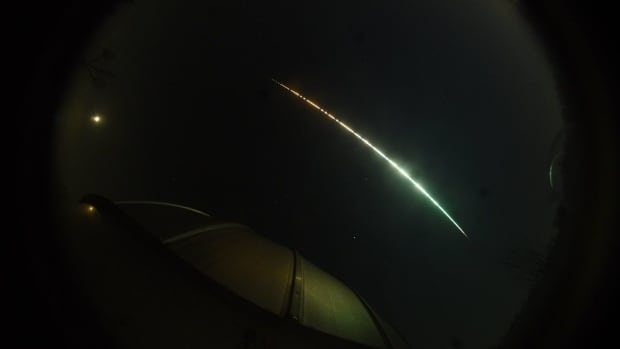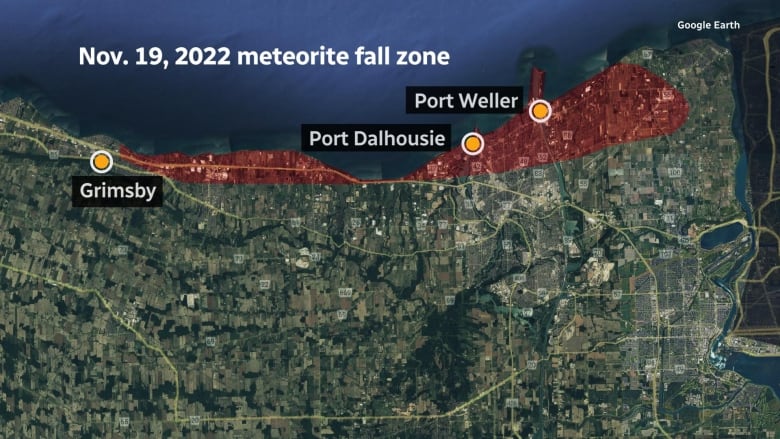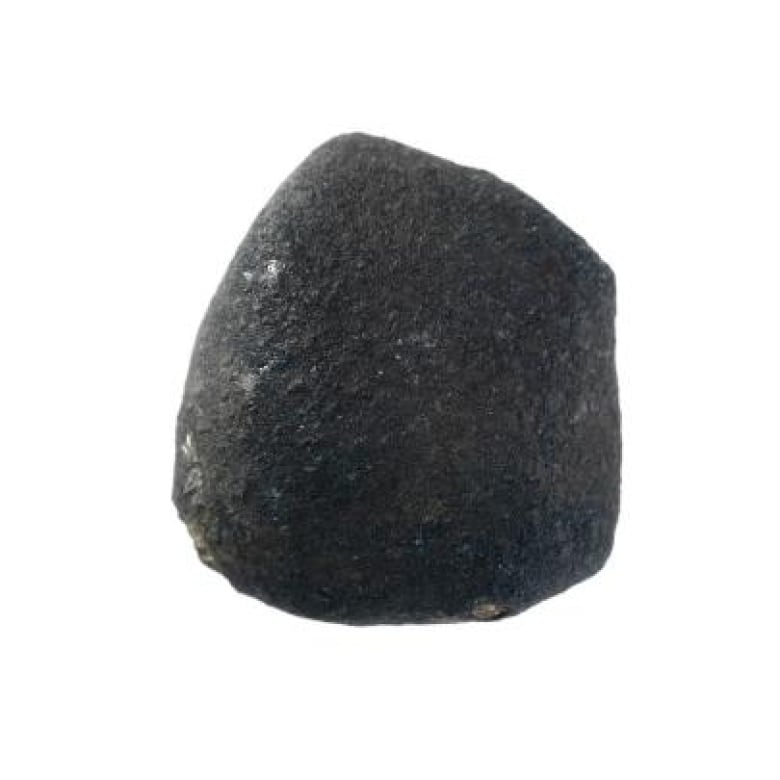
A meteorite, one metre in diameter, lit up the southern Ontario sky early Saturday morning before it crash landed into Lake Ontario and along the shoreline of Grimsby, Ont., in the Niagara region.
The landing now has scientists asking residents to keep an eye out for the space rocks — which could be billions of years old.
The European Space Agency said this is only the sixth time that a meteor, which turns into a meteorite as it falls to earth and breaks apart, has been detected well before impact by global asteroid warning systems.
The systems were able to tell scientists where and when the asteroid was going to hit.
The meteorite, labelled object C8FF042 by the National Aeronautics and Space Administration (NASA), hit Lake Ontario around 3:30 a.m. Saturday morning.
‘Rare occurrence in southern Ontario’
People across southern Ontario, from Toronto to Brantford, caught sight of the meteorite. Some shared home security camera footage on social media over the weekend of it catching fire and lighting up the night sky.
Others said they heard a loud sound around that time, which researchers CBC spoke to said was a sonic boom, made as the meteorite travelled faster than the speed of sound.
Here’s a full frame view of the bright <a href=”https://twitter.com/hashtag/fireball?src=hash&ref_src=twsrc%5Etfw”>#fireball</a> over <a href=”https://twitter.com/hashtag/SOnt?src=hash&ref_src=twsrc%5Etfw”>#SOnt</a> at around 3:26 a.m. EST, Nov 19/22. <a href=”https://twitter.com/esaoperations?ref_src=twsrc%5Etfw”>@esaoperations</a> says the ~1m asteroid <a href=”https://twitter.com/hashtag/C8FF042?src=hash&ref_src=twsrc%5Etfw”>#C8FF042</a> is now the 6th that was spotted before impact.<a href=”https://twitter.com/hashtag/meteor?src=hash&ref_src=twsrc%5Etfw”>#meteor</a> <a href=”https://twitter.com/hashtag/space?src=hash&ref_src=twsrc%5Etfw”>#space</a> <a href=”https://twitter.com/hashtag/Toronto?src=hash&ref_src=twsrc%5Etfw”>#Toronto</a> <a href=”https://twitter.com/TourCNTower?ref_src=twsrc%5Etfw”>@TourCNTower</a><br>(Credit <a href=”https://twitter.com/EarthCam?ref_src=twsrc%5Etfw”>@EarthCam</a>) <a href=”https://t.co/2e3lkfVhbG”>pic.twitter.com/2e3lkfVhbG</a>
—@ScottWx_TWN
Peter Brown, a physics professor at Western University in London, Ont., is a member of the Western Meteor Physics Group (WMPG), which studies meteors using cameras.
“We have a network of cameras in southern Ontario and southern Quebec and the network is constantly watching the night sky,” he said, adding that his meteor watching group has about 20 cameras trained at the sky.
Brown said WMPG’s goal is to capture footage of “bright meteors that produce fireballs,” like the one that landed in Lake Ontario over the weekend.
He said WMPG captured the meteor on 12 of their cameras, and that it was as “bright as the moon” and could have been seen across most of southern Ontario, in places where the clouds didn’t block it from view.
Brown said his group detects “several fairly bright meteors a night,” but said objects of this size — which is what creates the fireball — only hit the earth a few times a week and are rarely documented in southern Ontario, he said.
Bright fireball over Southern Ontario last night at 3:26 am caused by impact of asteroid 2022WJ1. This sub-meter-sized asteroid (one of the smallest NEAs ever detected) produced a spectacular fireball, though it was cloudy in many locations. Video from Western’s meteor network: <a href=”https://t.co/e5LkY7qWw4″>pic.twitter.com/e5LkY7qWw4</a>
—@pgbrown
“The fireball was only visible in southern Ontario, but there was a global network of telescopes and observers who were able to track the object as it came in,” he said, adding that the network of telescopes tracking the meteor from around the world will help advance meteor tracking science.
“We’re hoping people will… start looking for those rocks. Scientists are very interested in being able to get samples of those rocks,” he said.
Rocks from space are ‘frozen in time’ and ‘important’
Kim Tait is the mineralogy, meteorite and gem curator at the Royal Ontario Museum (ROM) and a former Hamilton resident.
Tait said she encourages people living near where the meteor hit in Niagara to keep an eye out for pieces of space rock, and consider donating their discoveries to the ROM, for Tait and her team to study.
“A lot of the rocks from space are 4 1/2 billion years old,” she said.
“On Earth we have such a dynamic planet that is recycling itself all the time, that has wind and rain and all these different features that change the rocks. But these [meteor] rocks are frozen in time from very early part of our solar system,” Tait said.

Brown said rock hunters can tell if it’s a piece of the meteor by its weight, colour and magnetism.
“Meteorites are are typically pretty heavy for their size. They’re high density, they’re magnetic usually, so a magnet will usually stick to them,” he said.
“They often have an outer crust that’s black, just like the black crust from a spacecraft that’s coming through the atmosphere. The reentry sort of melts the outer part of the meteorite.”
Brown said in particular residents of the Virgil, McNab and Port Weller areas of Niagara should keep an eye out for pieces of the meteor.
“Unfortunately it was a snowy weekend and things got buried pretty quickly,” Tait said.
“If everybody can have a little look out into the properties around the lake that would be amazing.”

Tait said whoever finds the pieces of the meteor can decide whether they want to keep it or donate it to the ROM, but she hopes they will at least contact the museum’s natural history department to have a scientist come and assess the rocks.
“In some cases people do like to to keep them and I completely respect [that] and understand,” she said.
“But every single time we open up one, there is something new to be discovered. So I think every rock from space is really important.”